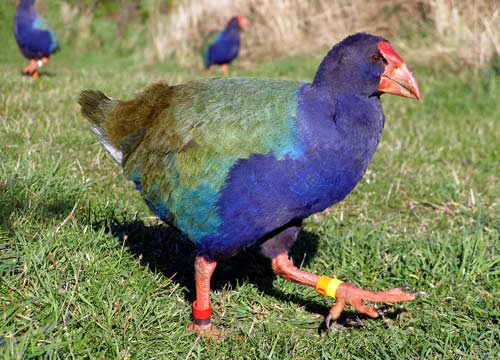Wildlife medicine in New Zealand is somewhat unique. There are a lot of critters here that don't exist anywhere else, and, conversely, things that aren't here that are everywhere else. During my time on wildbase, I sadly never got to see a snake or ferret. But I did get to see lots of super endangered native creatures, such as takahe. There's like 260 of them left.
And tuatara, which are basically dinosaurs, and the star of today's blog post.
They're basically prehistoric. They're so primitive, they're their own order. I know they look like lizards, but they're closer to dinosaurs. According to wikipedia, "The two species of tuatara are the only surviving members of their order, which flourished around 200 million years ago."
One of them came to the hospital with a diseased eye. It had probably been traumatised (eg poked it into a stick or something) and was now blind, or at least that's my understanding. All their heroic efforts to treat it medically had failed, so it came down to surgery. The first eye enucleation surgery to ever be performed in a tuatara.
The interesting thing about wildlife and exotic medicine is that there isn't a whole mountain of literature for every single species. You might be the second person ever to anaesthetise a giraffe with that combination of drugs, so all you have to go on is one twenty-year old case report and extrapolation from other species. Unfortunately that's not as easy as it sounds, because drugs can have dramatically different effects as species have small differences in enzymes or receptors or whatever. For instance, cats are massively different to dogs in some areas, and we have lots of research about those species. You can imagine how often we diagnose and treat the same disease in, say, a tiger. Now imagine how likely you are to find anything published about a species that numbers in the thousands.
The other fun thing about tuatara surgery is that reptiles are ridiculous animals. The way it was explained to me is that everything in birds happens super fast, they can turn on a dime, and everything that happens in reptiles happens super slow. If a reptile emergency comes in, the first thing you should do is put on the kettle, so you can have a think about it over your tea. Any changes in their health tend to take a long time to manifest. That is important information for this story.
We went ahead with the surgery, which was all quite exciting. It was especially exciting for anaesthesia, who were very stressed out. I don't remember the details because I wasn't on anaesthesia then, but things like heart rate and respiratory rate were apparently quite distressing. So while anaesthesia was freaking out, the wildlife clinician was calmly shrugging it off, with the explanation that some crocodillians can have heart rates as low as one beat per minute. Turtle hearts can keep beating for 24 hours after death (as in, when you open them up at necropsy, you can find their heart beating in front of you... even if you take it out, apparently). Basically, it's impossible to tell if they're dead or alive while under anaesthesia, so he decided not to worry about it. (It fits the theme of not being able to tell if animals are alive while on wildlife roster).
The surgery went along just fine. They packed the empty eye socket with some mini absorbable sponge thingies and sutured it all up. They made it a little bandage that made it look like a pirate. I have an adorable picture, but I doubt I'm supposed to share it on the internet (it might get picked up by google images or something and be stuck there forever when people search about tuatara, and then I think the university might get a teeny bit mad at me).
Details aside, things were fine and dandy that night and into the next morning. During the day, however, the tuatara slowed down, and in grand reptile fashion, we began to question whether it was alive or not. The clinicians broke out more heroics and it went under intensive care for most of the afternoon. Interestingly, since tuatara are in their own order, you need another tuatara if you want to do a blood transfusion... and there's not too many of them around, as you can imagine.
We had the little guy on oxygen, breathing for him, and all sorts of monitoring. He got drugs and fluids and blood products and heating pads and everything we could think of. Unfortunately the monitoring equipment isn't exactly built for tuatara, so the accuracy was questionable, making it even harder to tell anything about the heart or whatever. The heart rate went down and he wouldn't breathe for himself. We did what we could, and gave it a few hours for good measure. He had gone very pale. Surprisingly, we still couldn't figure out if he was actually dead, so we stopped breathing for him and let the chips fall as they may. We put him back in the incubator for the night, just to be sure. The next morinng he hadn't moved any, so we were getting pretty confident we'd lost him.
Too bad for the world's first enucleation on a tuatara. The upside of taking two days to die is that we'd all kind of... accepted it. By the time we gave up on him, I had plenty of time to prepare myself emotionally so I wasn't particularly upset. If he'd given up the ghost in the middle of surgery or something, that would have been more difficult to deal with.


No comments:
Post a Comment